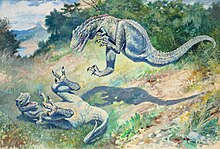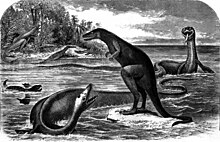Dryptosaurus
| Dryptosaurus Temporal range: Late Cretaceous,
| |
|---|---|

| |
| Illustrated fossil remains | |
| Scientific classification | |
| Kingdom: | |
| Phylum: | |
| Class: | |
| Superorder: | |
| Order: | |
| Suborder: | |
| Superfamily: | |
| Family: | Dryptosauridae Marsh, 1890
|
| Genus: | Dryptosaurus Marsh, 1877
|
| Species | |
Dryptosaurus (from Greek Drypto, "tear" and Sauros, "lizard" ) was a genus of primitive tyrannosaur that lived in Eastern North America during the middle Maastrichtian stage of the Late Cretaceous period. A famous painting of the genus by Charles R. Knight has made it one of the more widely-known dinosaurs, in spite of its poor fossil record. Its specific name aquilunguis is Latin for "having claws like an eagle's".
Description

Dryptosaurus was 6.5 m (20 feet) long, 1.8 m (6 feet) high at the hips, and weighed about 1.2 tons. Like its relative Eotyrannus, it had relatively long arms with three fingers. Each of these fingers was tipped by a talon-like 8 inch claw.[1] These claws lend a meaning for the type species aquilunguis: eagle-clawed.
Discovery and species
In 1866, an incomplete skeleton (ANSP 9995) was found in New Jersey by workers in a quarry belonging to the upper part of the New Egypt Formation.[1] Paleontologist E.D. Cope described the remains, naming the creature "Laelaps" ("storm wind", after the dog in Greek mythology that never failed to catch what it was hunting).[2] "Laelaps" became one of the first dinosaurs described from North America (following Hadrosaurus, Aublysodon and Trachodon). Subsequently, it was discovered that the name "Laelaps" had already been given to a genus of mite, and Cope's lifelong rival O.C. Marsh changed the name in 1877 to Dryptosaurus.
During the 19th Century, numerous theropod species in North America were referred to the genus Dryptosaurus (often as Laelaps), only to be re-classified as different genera. Only one potential second species is sometimes recognized today, D. macropus. Known from a partial hind limb found in the Navesink Formation (probably roughly equivalent to the New Eagle Formation in time), Leidy originally referred the specimen to Coelosaurus. Cope later recognized it as a distinct species, referring to it is Laelaps macropus, differing from the specimen know known as Dryptosaurus by its longer toes. Subsequently, most scientists had concluded that it probably belonged to Coelosaurus after all, but in 2004 paleontologist Thomas R. Holtz listed it as an indeterminate tyrannosauroid possibly referable to the genus Dryptosaurus.[3]
Classification
Before the discovery of Appalachiosaurus,[4] Dryptosaurus was classified in a number of theropod families. Originally considered a megalosaurid by Cope, it was later assigned to its own family (Dryptosauridae) by Marsh, and later found (through phylogenetic studied of the 1990s) to be a coelurosaur, though its exact placement within that group remained uncertain. The discovery of the closely related (and more complete) Appalachiosaurus made it clear that Dryptosaurus was a primitive tyrannosauroid.
The fossil material assigned to Dryptosaurus was reviewed by Ken Carpenter in 1997 in light of the many different theropods discovered since Cope's day. He felt that due to some unusual features it couldn't be placed in any existing family and warranted placement in its own family, Dryptosauridae.[5] Dryptosaurus was the only large carnivore known in eastern North America before the discovery of Appalachiosaurus.
"Laelaps" trihedrodon
Although the type specimen included a partial dentary, all material except for a collection of five damaged partial tooth crowns (AMNH 5780) has been lost. AMNH 5780 has many features in common with Allosaurus and is probably referrable to that genus. However some of the Allosaurus-like characters of the tooth are primitive to theropods as a whole and may have been present in the less studied or poorly preserved Morrison theropod species. Consequently the synonymization of L. trihedrodon with Allosaurus is tentative, despite its high likelihood.[6]
Paleoecology

Although certainly a carnivore, the paucity of known Cretaceous east coast dinosaurs make ascertaining the specific diet of Dryptosaurus difficult.[1] Hadrosaurids are known from the same time and place as Dryptosaurus, the island continent of Appalachia, and they may have been a prominent part of its diet. Nodosaurs were also present although less likely to be hunted due to their armor plating.[1]
References
- ^ a b c d "Dryptosaurus." In: Dodson, Peter & Britt, Brooks & Carpenter, Kenneth & Forster, Catherine A. & Gillette, David D. & Norell, Mark A. & Olshevsky, George & Parrish, J. Michael & Weishampel, David B. The Age of Dinosaurs. Publications International, LTD. p. 112-113. ISBN 0-7853-0443-6.
- ^ Cope, E.D. (1866). "Discovery of a gigantic dinosaur in the Cretaceous of New Jersey." Proceedings of the Academy of Natural Sciences of Philadelphia, 18: 275-279.
- ^ Holtz, T.R. (2004). "Tyrannosauroidea." Pp. 111-136 in Weishampel, Dodson and Osmolska (eds). The Dinosauria (second edition). University of California Press, Berkeley.
- ^ Carra, T.D., Williamson, T.E., and Schwimmer, D.R. (2005). "A new genus and species of tyrannosauroid from the Late Cretaceous (middle Campanian) Demopolis Formation of Alabama". Journal of Vertebrate Paleontology. 25 (1): 119–143. doi:10.1671/0272-4634(2005)025[0119:ANGASO]2.0.CO;2.
{{cite journal}}: CS1 maint: multiple names: authors list (link) - ^ Carpenter, Ken & Russell, Dale A, Donald Baird, and R. Denton (1997). "Redescription of the holotype of Dryptosaurus aquilunguis (Dinosauria: Theropoda) from the Upper Cretaceous of New Jersey" ([dead link]). Journal of Vertebrate Paleontology. 17 (3): 561–573. doi:10.1080/02724634.1997.10011003.
{{cite journal}}: CS1 maint: multiple names: authors list (link) - ^ Chure, Daniel J. (2001). "On the type and referred material of Laelaps trihedrodon Cope 1877 (Dinosauria: Theropoda)". Mesozoic Vertebrate Life. Bloomington and Indianapolis: Indiana University Press. pp. 10–18. ISBN 0-253-33907-3.
{{cite book}}: Unknown parameter|editors=ignored (|editor=suggested) (help)
- Carr and Williamson (2002). "Evolution of basal Tyrannosauroidea from North America". Journal of Vertebrate Paleontology. 22 (3): 41A.
- [1] - Cretaceous Dinosaurs of the Southeastern United States by David T. King Jr.
